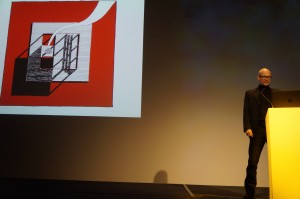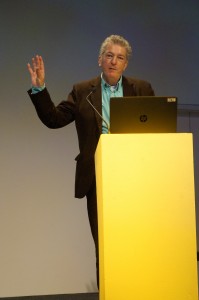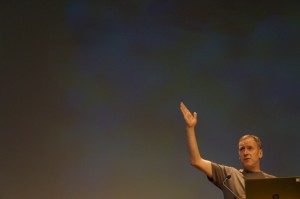Keynote Presentation: Marco Casagrande
 Marco Casagrande a Finnish architect, environmental artist and social theorist talks here about his work that moves freely in-between art, architecture and science with the focus on the connection of the modern man with nature. In this presentation he discusses his theory of the Third Generation City presenting as a bio-urban future with the industrial city turned into an organic machine, “the ruin of the industrial city – ruin is when man-made has become part of nature.” The 3G condition will be achieved through self organized community actions of urban acupuncture that will manipulate the neuro-ergonomics of the existing cities towards learning and healing process of bio-urban restoration.
Marco Casagrande a Finnish architect, environmental artist and social theorist talks here about his work that moves freely in-between art, architecture and science with the focus on the connection of the modern man with nature. In this presentation he discusses his theory of the Third Generation City presenting as a bio-urban future with the industrial city turned into an organic machine, “the ruin of the industrial city – ruin is when man-made has become part of nature.” The 3G condition will be achieved through self organized community actions of urban acupuncture that will manipulate the neuro-ergonomics of the existing cities towards learning and healing process of bio-urban restoration.
Marco Casagrande PDF
Presentation: Angus Farquhar
Angus Farquhar, Creative Director of NVA organisation based in Glasgow, talks here about the rescucitation of one of the best known modernist buildings in Europe. St Peter’s Seminary set in the ancient 140 acre Kilmahew woodlands, near Cardross on the firth of Clyde. The work which was recently presented at the Venice Biennale involves the purchase of and partial restoration of the first intentional modernist ruin in the UK. Long term plans include the development of a future field station The Invisible College working with key Scottish University Partners, utilising the’ site as subject’ leading to an annual public art commissions and a radical generative interpretation plan.
Angus Farquhar PDF
Presentation: Professor Malcolm Miles
 The way climate change is encountered has changed over the past twenty years. Once it was a not too daunting picture of a warmer climate plus campaigns to save various (mainly nice) species, now it’s violent weather, and impending wars over natural resources, forced migrations, and Earth as a dust bowl. If the difficulty is that global capital relentlessly processes the environment – seen as mere resource – into dust, is it worth looking to art for interventions in face of climate change? The presentation looks at a few examples of critical-aesthetic practices and argues that while the issue is political it can also be addressed culturally. Malcolm Miles expands on this in his new book: Eco-Aesthetics (Bloomsbury, 2014), and is Professor of Cultural Theory in the Architecture School at the University of Plymouth.
The way climate change is encountered has changed over the past twenty years. Once it was a not too daunting picture of a warmer climate plus campaigns to save various (mainly nice) species, now it’s violent weather, and impending wars over natural resources, forced migrations, and Earth as a dust bowl. If the difficulty is that global capital relentlessly processes the environment – seen as mere resource – into dust, is it worth looking to art for interventions in face of climate change? The presentation looks at a few examples of critical-aesthetic practices and argues that while the issue is political it can also be addressed culturally. Malcolm Miles expands on this in his new book: Eco-Aesthetics (Bloomsbury, 2014), and is Professor of Cultural Theory in the Architecture School at the University of Plymouth.
Malcolm Miles PDF
Photo credits: MM except slide 8 Cornford & Cross; 9 HeHe, 10 Liberate Tate
Presentation: Alice Sharp
 Alice Sharp talks about her work as the Curator and Director of Invisible Dust, an art and science organisation in 2009 involving artists, scientists and creative technologists in producing exciting commissions exploring the environment and climate change. In this presentation Alice discusses the most recent commissions of Invisible Dust including HighWater Line Bristol about flooding resilience, Invisible Heat a new project on the health affects of Climate Change and ‘Invisible Dust in Museums.’ In this Elizabeth Price 2012 Turner Prize winner will exhibit at the National Maritime Museum, Laura Harrington at the Woodhorn Museum and Owl Project at the Manchester Museum.
Alice Sharp talks about her work as the Curator and Director of Invisible Dust, an art and science organisation in 2009 involving artists, scientists and creative technologists in producing exciting commissions exploring the environment and climate change. In this presentation Alice discusses the most recent commissions of Invisible Dust including HighWater Line Bristol about flooding resilience, Invisible Heat a new project on the health affects of Climate Change and ‘Invisible Dust in Museums.’ In this Elizabeth Price 2012 Turner Prize winner will exhibit at the National Maritime Museum, Laura Harrington at the Woodhorn Museum and Owl Project at the Manchester Museum.


